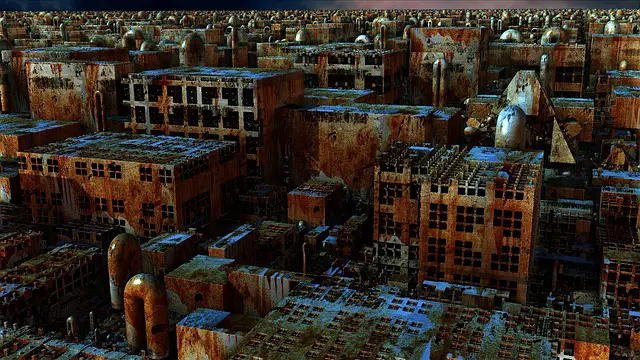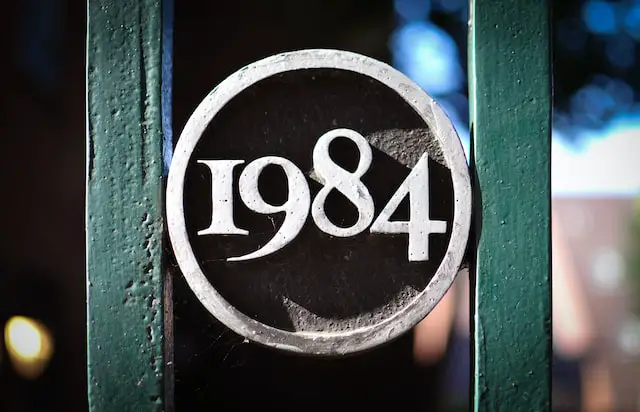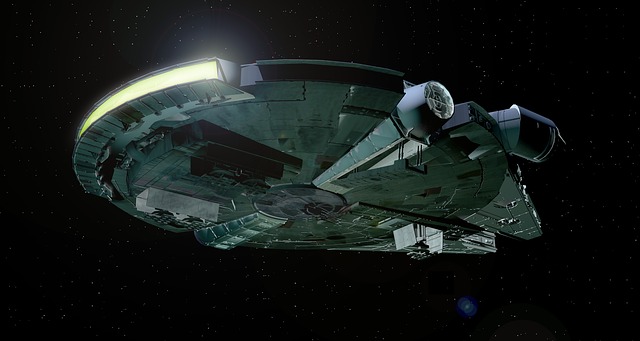Science fiction and dystopian fiction have always been closely related but at the same time, they have their own distinct characteristics. Science fiction involves exploring futuristic scenarios based on scientific and technological advances while dystopian fiction focuses more on oppressive social structures that are often the result of a society’s progress. Although the two genres share some common themes, they ultimately offer different types of reading experiences to readers depending upon which one they choose to pursue.
What is science fiction?
(Photo by Maksim Istomin on Unsplash )

Science fiction is a genre of speculative fiction that deals with imaginative and futuristic concepts such as advanced science and technology, space exploration, time travel, parallel universes, and extraterrestrial life. Science fiction often explores the potential consequences of scientific, social, and technological innovations.
What is dystopian fiction?
(Image by Carroll MacDonald from Pixabay )

Dystopian fiction is a subgenre of science fiction that envisions a society in which conditions are so bad that it is oppressive or frightening. Dystopian societies usually have an authoritarian or totalitarian government, surveillance states, scarce resources, and little to no individual freedoms.
The similarities and differences between science fiction and dystopian fiction
Science fiction and dystopian fiction are both genres of speculative fiction. Speculative fiction is a genre of literature that explores the possibilities of future worlds, often through the lens of science and technology. Science fiction generally focuses on positive depictions of future worlds, while dystopian fiction tends to be more dark and pessimistic.
Both genres often explore social and political issues, but they do so in different ways. Science fiction typically offers a optimistic view of the future, whereas dystopian fiction presents a more realistic or even negative view. Science fiction often deals with themes such as space exploration, time travel, and parallel universes; dystopian fiction usually focuses on things like totalitarian governments, pollution, and scarce resources.
So, what’s the difference between science fiction and dystopian fiction? In a nutshell, it’s all about perspective. Science fiction offers us a glimpse into what could be, while dystopian fiction shows us what could go wrong.
Examples of science fiction and dystopian fiction
Science fiction and dystopian fiction are two genres that are often confused for one another. While they both deal with futuristic worlds, there are some key differences between the two. Science fiction is a genre of speculative fiction that deals with imaginative and futuristic concepts such as advanced science and technology, space exploration, time travel, parallel universes, etc. On the other hand, dystopian fiction is a genre of speculative fiction that depicts a society in which the conditions of life are miserable and difficult.
Science fiction and dystopian fiction often overlap, but there are some key examples that help to differentiate between the two genres. For instance, “The Hunger Games” is a well-known dystopian novel that tells the story of a society in which children are forced to compete in a deadly game. On the other hand, “The Martian” by Andy Weir is an example of science fiction as it deals with the idea of a man being stranded on Mars.
In general, science fiction tends to be more optimistic than dystopian fiction. Science fiction often explores the potential for humanity to progress and advance, while dystopian novels tend to focus on the dark side of human nature and warn against the dangers of technology and progress.
Is science fiction always dystopian?
No, science fiction is not always dystopian. In fact, science fiction can be optimistic and even utopian, depicting a future world that is better than the present one. However, dystopian fiction is by definition dark and pessimistic, showing a future world that is worse off than the present one.
What are examples of dystopian fiction books?
- 1984 by George Orwell – This classic novel explores a totalitarian society in which the government exerts complete control over its citizens through surveillance and censorship.
- Brave New World by Aldous Huxley – This novel explores a society in which individuals are genetically engineered and conditioned to conform to a rigid social hierarchy.
- The Hunger Games by Suzanne Collins – This novel is set in a post-apocalyptic society in which children are forced to participate in a brutal, annual televised battle to the death.
- The Handmaid’s Tale by Margaret Atwood – This novel explores a society in which women are stripped of their rights and forced into reproductive slavery.
- Fahrenheit 451 by Ray Bradbury – This novel is set in a society in which books are banned and firemen are tasked with burning any that are found.
- The Road by Cormac McCarthy – This novel is set in a post-apocalyptic world where most of the human population has been killed, the survivors struggle to survive.
- The Children of Men by P.D James – This novel explores a world where infertility has led to the collapse of society.
- The Giver by Lois Lowry – This novel explores a society in which conformity is valued above all else, and individuality is suppressed.
These are some of the most popular dystopian fiction books, but there are many other examples of dystopian fiction out there as well.
Is Harry Potter dystopian or fantasy?
The Harry Potter series has often been classified as fantasy, but there are elements of the books that could be considered dystopian. For example, the wizarding world is hidden from the non-magical population, and there is a strict system of government in place. Additionally, many of the characters are struggling with difficult personal circumstances. While Harry Potter is not typically considered a dystopian novel, it does have some characteristics of one.
What is the most famous dystopian story?
(Photo by Viktor Forgacs on Unsplash )

There can be no doubt that the most famous dystopian story is George Orwell’s 1984. Published in 1949, this classic novel paints a picture of a future society where people are kept in line by a tyrannical government that controls every aspect of their lives. With its depiction of a world where freedom and individuality are crushed under the heel of an all-powerful state, 1984 has served as a warning to generations of readers about the dangers of totalitarianism.
What are examples of science fiction books?
- The Hitchhiker’s Guide to the Galaxy by Douglas Adams – This comedic science fiction series follows the misadventures of an unwitting human and his alien friend as they travel through space.
- Dune by Frank Herbert – This epic science fiction novel is set in a distant future and explores themes of politics, religion, and ecological disaster as humanity fights for control of a desert planet.
- The War of the Worlds by H.G. Wells – This classic science fiction novel explores the idea of a Martian invasion of Earth.
- Ender’s Game by Orson Scott Card – This novel is set in a future where humanity is at war with an alien race, and follows the story of a child prodigy who is trained to become a commander of a space fleet.
- Foundation by Isaac Asimov – This classic science fiction series explores the idea of a galactic empire on the brink of collapse and a group of scientists who try to save it using psychological manipulation and scientific prediction.
- The Martian by Andy Weir – This novel tells the story of an astronaut stranded on Mars and his efforts to survive and return to Earth.
- The Time Machine by H.G. Wells – This novel is about a time traveler who travels through different eras, it’s considered one of the first time-travel story.
- Neuromancer by William Gibson – This novel is a classic of cyberpunk science fiction and explores a dystopian future in which advanced technology has led to the collapse of society.
What is the most famous science fiction story?
Science fiction and dystopian fiction are both genres of speculative fiction. Speculative fiction is a genre of literature that explores the possibilities of future worlds. Science fiction stories often explore the effects of science and technology on society, while dystopian stories typically explore the implications of totalitarianism or other forms of social control.
The most famous science fiction story is probably Mary Shelley’s Frankenstein. The novel has been adapted for film and television numerous times, and its themes of science gone wrong have resonated with audiences for centuries. Other well-known science fiction stories include H.G. Wells’ The War of the Worlds and Isaac Asimov’s Foundation series.
Who is the father of dystopian literature?
The father of dystopian literature is generally considered to be George Orwell, with his novel 1984. Dystopian literature takes the ideas and aspirations of science fiction and uses them to create a nightmarish vision of the future. In dystopian literature, society is often controlled by a totalitarian government, and people’s lives are carefully regulated. There is often little room for personal freedom, and citizens are often kept under strict surveillance.
Who is the father of Sc-fi literature?
Isaac Asimov is considered one of the most influential writers of science fiction. He wrote hundreds of short stories and over 50 books. His work helped to shape the genre of science fiction. He is best known for his Foundation series, which tells the story of a future society that is governed by an intricate system of psychohistory.
What are the types of dystopia?
There are three types of dystopia: Political, Social, and Technological.
Political dystopian fiction is about a government or society that is oppressive and controlled.
Social dystopian fiction is about a society that is stratified and unequal.
Technological dystopian fiction is about a future where technology has gone too far and has created a world that is dangerous or difficult to live in.
What are six important elements of dystopian fiction?
- A dystopian novel typically takes place in the future, in a world that is significantly different from our own.
- The society in a dystopian novel is often one that is oppressive and controlled by a central government or ruling class.
- Characters in a dystopian novel often struggle against the unjust systems they live under.
- Dystopian novels often explore themes of totalitarianism, environmental disaster, and/or technological control.
- Many dystopian novels are dark and pessimistic in tone, with few moments of hope or happiness.








